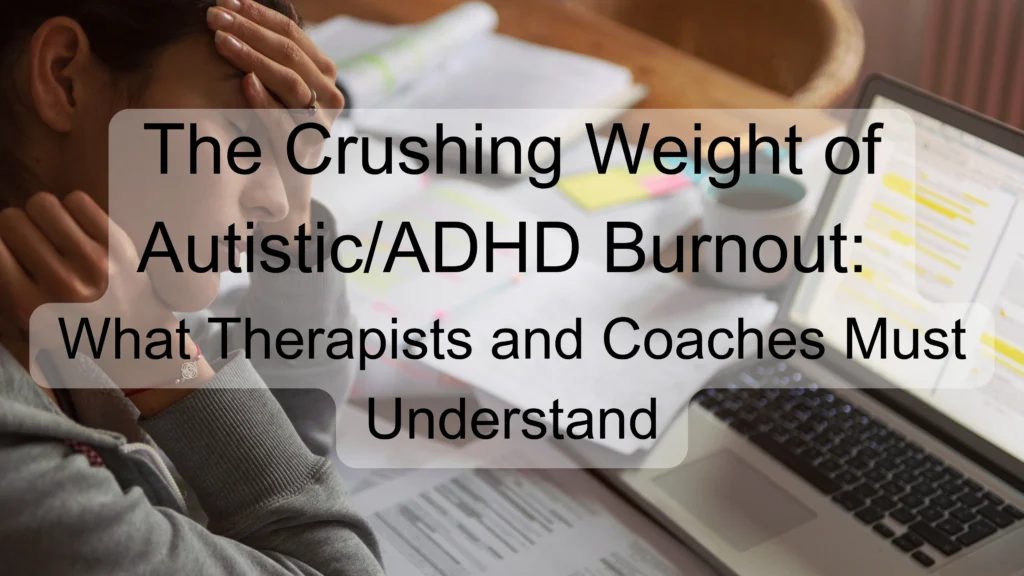The Crushing Weight of Autistic/ADHD Burnout: What Therapists and Coaches Must Understand
Burnout isn’t just stress. For autistic and ADHD people—especially those of us who are both, known as AuDHD—it’s a shutdown of the whole self. It’s physical, emotional, cognitive, and spiritual depletion. It’s when the body says no more, and the mind echoes it back with silence or despair. Yet all too often, therapists and coaches miss it, mislabel it, or worse, pathologise it without context.
Autistic/ADHD burnout is real, and it’s not a character flaw. It’s a survival response to chronic overload in a world that wasn’t designed for our neurology. It’s time we stopped treating it like depression or laziness and started seeing it for what it is: a human system in collapse.
Burnout Looks Different Here
You can’t spot neurodivergent burnout by looking for the usual signs. AuDHD burnout isn’t just fatigue or demotivation. It can look like:
- Loss of previously mastered skills
- Executive dysfunction on overdrive
- Loss of speech or the ability to mask
- Emotional volatility or numbness
- Heightened sensory sensitivity
- Complete social withdrawal
And it can last weeks, months, even years.
As Devon Price, author of Unmasking Autism, puts it:
“Autistic burnout feels like your mind has short-circuited. Like you’re a phone that’s been left off the charger too long. You’re not just tired. You’re gone.”
Why It Happens: The Accumulation of “Too Much”
Autistic/ADHD people live under a constant barrage of sensory input, unspoken social rules, executive demands, and internal pressure to keep up. We are often masking—suppressing stims, forcing eye contact, mimicking neurotypical behaviour—all in order to survive socially or professionally.
This isn’t just tiring. It’s eroding.
A 2020 study published in Autism in Adulthood found that 89% of autistic adults surveyed reported experiencing burnout, often lasting longer than a year. Many linked it directly to high demands for camouflage in work or social environments.
ADHD adds another layer: the chronic self-reproach of not doing “enough,” even as we fight through decision paralysis, distractibility, or emotional flooding. Add in rejection sensitivity and a culture that rewards hustle over health, and we’re primed for collapse.
Burnout Isn’t Depression—Though It Looks Like It
The misdiagnosis problem is serious. Autistic/ADHD burnout is often mistaken for depression or even personality disorders. The crucial difference? Burnout stems from overload, not from inner despair, but from external unsustainability.
Yes, burnout can cause depressive symptoms. But the intervention is different. Antidepressants may dull the edge, but they won’t stop the flood. What’s needed is radical nervous system relief: less masking, more authenticity; less demand, more support; less pushing, more rest.
Burnout isn’t healed by doing more—it’s healed by doing less, differently.
What Therapists and Coaches Must Stop Getting Wrong
One of the most damaging things we can do is expect “resilience” in the form of more coping. More strategies. More effort. We have to ask: Resilient to what? A system that’s eating people alive?
The path forward isn’t about making autistic or ADHD people better at fitting in. It’s about helping them find where they already fit, and strip away the need to perform.
This means:
- Understanding that shutdown isn’t avoidance—it’s a neurological brake.
- Respecting sensory boundaries instead of encouraging “tolerance.”
- Listening without pathologising. Rebuilding without rushing.
We can’t coach or therapise someone out of burnout. But we can walk beside them as they reclaim what’s sustainable and safe.
Recovery Is Possible—But Not Quick
There is no hack for recovery. No three-step plan. Recovery from burnout requires permission, space, and safety. It may mean quitting the job. Saying no to the family dinner. Dropping the mask for the first time in decades.
It might involve grieving the years lost to performance, or the support that was never there.
But it also brings clarity. Burnout, brutal as it is, shows what was never working. And that insight is sacred.
As one client said to me, “Burnout is what finally let me be autistic. I stopped pretending. I started choosing.”
A Call to Our Community
If you’re a therapist or coach reading this, your role is pivotal. You are often the first safe place an AuDHD person lands when they’re unravelling. Please know what you’re looking at. Don’t offer tidy CBT tools for a nervous system on fire. Offer rest, validation and slowness.
And to those of us who are neurodivergent: your burnout is not your fault. You are not broken. You’re responding exactly as a human should when forced to run at full speed in the wrong direction.
You don’t need to become more functional. You need to become more you, on your terms.
Let that be the new goal.
Download your FREE Professional Cheat Sheet here

